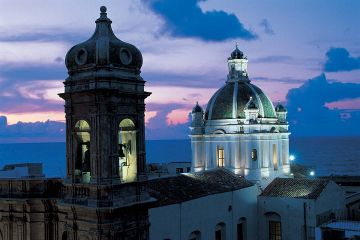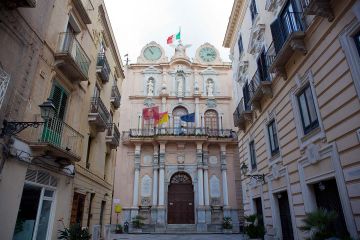
Trapani is an historical city, full of nobles buildings and churches of various eras and styles. It also houses some real gems, such as the Monumental Organ of San Pietro, the largest in Europe. It is very simple to reach it from San Vito lo Capo, just hire a car and reach all the destinations you want.
In the historic center of Trapani there are a series of buildings and churches of considerable interest: the Church of San Francesco d'Assisi, the Church of the Capuchins, the church of San Pietro and that of Purgatory, located in the homonymous square. But above all: the Cathedral of San Lorenzo, in Corso Vittorio Emanuele, built in the seventeenth century on a previous fourteenth-century building; the Collegium Church of the Jesuits, recently interested in restoration works.
The interior of the cathedral is divided into three naves divided by two rows of columns and the dome central is surrounded by four other smaller ones. The canvases, of high artistic value, preserved in the Cathedral, are different: The Crucifixion by Van Dyck, San Giorgio by Andrea Carreca, Father Eternal by Domenico La Bruna and a statue of dead Christ by Giacomo Tartaglia.
The Church of the Jesuits College, designed in 1614 by the Messina architect Natale Masuccio, is one of the most significant Baroque monuments in the city. The interior, with three naves, is richly decorated with mixed marbles, on the model of the Baroque churches of Palermo. The vault is embellished with stuccoes, the work of Bartolomeo Sanseverino, disciple of the famous Giacomo Serpotta (18th century). On the main altar, an icon by Ignazio Marabitti (1711) represents the Immaculate Conception. The façade, designed by Francesco Bonamici, is a clear example of the transition between Baroque and Mannerism.
Also worth a visit is the Church of San Pietro, which gives its name to the oldest district of the city and stands on a site where cults were probably officiated pre- Christian in honor from Saturn. The flagship of the Church is its splendid organ monumental, built by Francesco La Grassa in 1842 and made up of four thousand reeds. The organ of San Pietro, completed only in 1847, is one of the most complex instruments built in all of Europe, with the seven keyboards distributed in three consoles.
One of the most attractive streets of the city is via Garibaldi, flanked by eighteenth-century palaces and churches, including Palazzo Riccio di Morana, crowned by statues, Palazzo Milo and the Badia Nuova (S. Maria del Soccorso) one of the oldest churches in the city.

The palace that closes the street in a scenographic way is Palazzo Senatorio, or Cavarretta, whose facade is on two orders marked by columns and statues and is crowned by two large watches. Next to it is the 13th century clock tower.
Also worth visiting is via Libertà, where you can find the church of Carmine, in Renaissance style founded by the Carmelite Fathers, Palazzo Fardella and Palazzo Sanseverino.
Finally they deserve a mention: Palazzo Ciambra, built in the century. XVI from the Ciambra family, also called “della Giudecca” because it was built in the ancient ghetto after the Jews were expelled from the city, following the edict of Ferdinando il Cattolico (1492); Palazzo della Vicaria, characterized, on the facade, by four imposing telamons in stuccoed tuff, once used as a prison, now home to exhibitions and public events.
I TRE GOLFI is pleased to provide tourist information and assist ON-SITE users in planning their vacation in San Vito lo Capo and western Sicily.
Check-in / Check-out
+39 392 2338204

